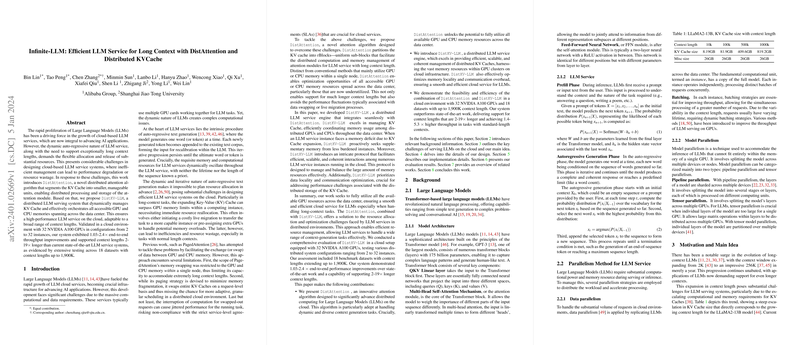Efficient Management of LLM Services for Long Contexts in Cloud Environments
Introduction to DistAttention and DistKV-LLM
In the rapidly evolving landscape of AI and machine learning, LLMs have emerged as foundational blocks, driving advances in diverse applications ranging from chatbots to automated content generation. However, as these models scale, particularly in cloud-based services, they present unique challenges in managing the extensive computational and memory resources required, especially for tasks involving long-context sequences. This paper introduces a significant stride towards addressing these challenges through DistAttention, a novel distributed attention algorithm, and DistKV-LLM, an innovative engine optimized for efficient management of distributed Key-Value (KV) Caches.
The Challenges Addressed
The dynamic and auto-regressive nature of LLMs imposes difficulties in predetermining resources, particularly for tasks with variable context lengths. This unpredictability often leads to inefficient resource allocation, impacting performance and scalability within cloud environments. The traditional model parallelism techniques, while useful, fall short when dealing with the memory demands imposed by long-context sequences. Moreover, existing solutions like live migration or memory swapping, despite their potential, introduce significant overheads or fail to utilize available resources effectively.
DistAttention: A Distributed Attention Mechanism
DistAttention addresses these challenges by segmenting the KV Cache into smaller, manageable units, enabling distributed processing across a cloud-based environment. This not only facilitates efficient memory management but also circumvents the performance bottlenecks associated with data swapping or live migrations. By leveraging all accessible GPU and CPU memory resources across the data center, DistAttention optimizes resource utilization, significantly enhancing the system’s adaptability and performance for long-context tasks.
DistKV-LLM: Streamlining KV Cache Management
Building on the foundation laid by DistAttention, DistKV-LLM emerges as a distributed LLM service engine optimized for managing KV Caches effectively across distributed GPUs and CPUs in a data center. It introduces a sophisticated protocol ensuring scalable, coherent interactions among numerous LLM service instances, addressing the challenges associated with the dynamicity and unpredictability of resource demands. DistKV-LLM’s architecture prioritizes data locality and communication efficiency, crucial for maintaining performance in long-context scenarios.
Evaluation and Findings
The proposed system was rigorously tested in a cloud setup equipped with 32 NVIDIA A100 GPUs across various configurations. Through extensive benchmarking with 18 datasets, the system demonstrated remarkable performance improvements (1.03-2.4 times higher throughput) and supported context lengths 2-19 times longer than existing state-of-the-art LLM service systems. These results not only validate the effectiveness of the proposed solutions but also highlight the potential for substantial performance gains in practical deployments.
Implications and Future Directions
The innovations presented in this paper, comprising DistAttention and DistKV-LLM, offer a powerful toolkit for optimizing LLM services in cloud environments. By addressing the core challenges associated with long-context sequence tasks, this research paves the way for more efficient, scalable, and adaptable LLM services. Looking ahead, the principles and mechanisms outlined here could inspire new avenues of research and development, focusing on leveraging distributed computing resources for advanced AI applications.
In summary, this paper contributes significantly to the field of AI and cloud computing by offering a robust solution to the pressing challenges of managing LLM services for long-context tasks. As LLMs continue to grow in size and complexity, the strategies and technologies developed in this work will undoubtedly play a critical role in the future evolution of cloud-based AI services.
